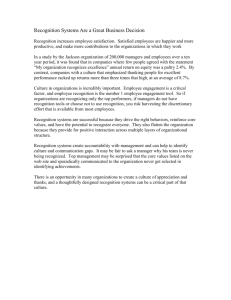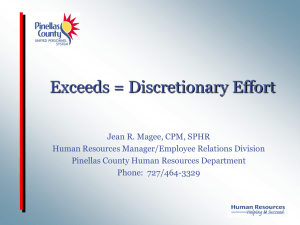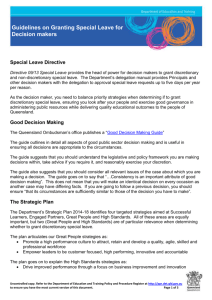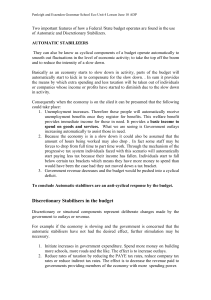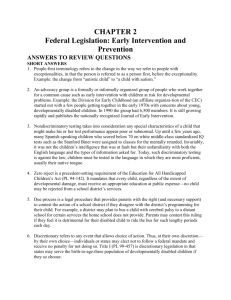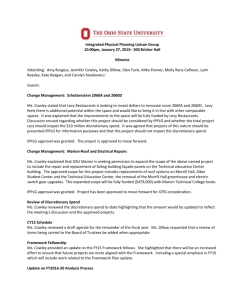The Breakdown of Fixed and Variable Cost in Economic and
advertisement
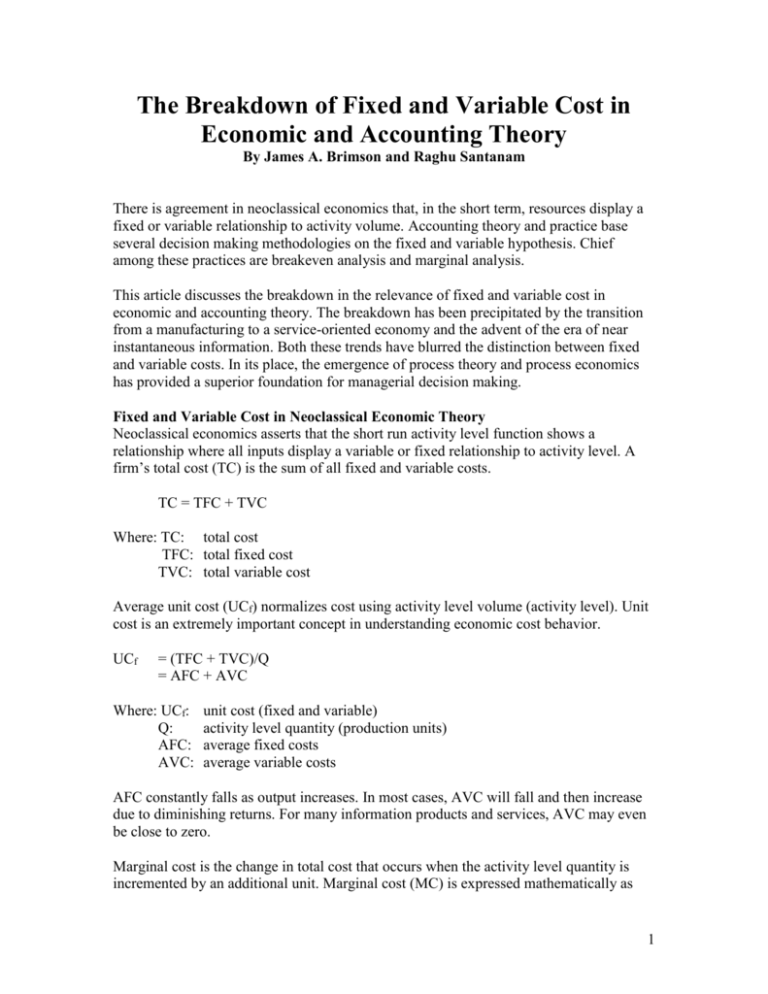
The Breakdown of Fixed and Variable Cost in Economic and Accounting Theory By James A. Brimson and Raghu Santanam There is agreement in neoclassical economics that, in the short term, resources display a fixed or variable relationship to activity volume. Accounting theory and practice base several decision making methodologies on the fixed and variable hypothesis. Chief among these practices are breakeven analysis and marginal analysis. This article discusses the breakdown in the relevance of fixed and variable cost in economic and accounting theory. The breakdown has been precipitated by the transition from a manufacturing to a service-oriented economy and the advent of the era of near instantaneous information. Both these trends have blurred the distinction between fixed and variable costs. In its place, the emergence of process theory and process economics has provided a superior foundation for managerial decision making. Fixed and Variable Cost in Neoclassical Economic Theory Neoclassical economics asserts that the short run activity level function shows a relationship where all inputs display a variable or fixed relationship to activity level. A firm’s total cost (TC) is the sum of all fixed and variable costs. TC = TFC + TVC Where: TC: total cost TFC: total fixed cost TVC: total variable cost Average unit cost (UCf) normalizes cost using activity level volume (activity level). Unit cost is an extremely important concept in understanding economic cost behavior. UCf = (TFC + TVC)/Q = AFC + AVC Where: UCf: Q: AFC: AVC: unit cost (fixed and variable) activity level quantity (production units) average fixed costs average variable costs AFC constantly falls as output increases. In most cases, AVC will fall and then increase due to diminishing returns. For many information products and services, AVC may even be close to zero. Marginal cost is the change in total cost that occurs when the activity level quantity is incremented by an additional unit. Marginal cost (MC) is expressed mathematically as 1 the first derivative of the total cost (TC) function with respect to activity level quantity (Q). Marginal cost addresses the question: how much will it cost to produce one additional unit of output? MC equals slope of the total cost function and the variable cost function. MC = ∂TC/∂Q A key assumption underpinning marginal cost analysis is that of diminishing marginal returns. If we add more variable input(s) to fixed inputs, then the average unit cost will decline. The total cost curve will flatten out as the quantity of the variable input increases. Therefore, marginal cost may fall initially, but it must eventually increases but at a decreasing rate. Fixed and variable theory is an essential condition of breakeven analysis. A firm will breakeven when its total sales or revenues equal its total expenses. At the breakeven point, no profit will have been made, nor have any losses been incurred. Breakeven point is the lower limit of profit when determining margins. Breakeven is calculated as follows: BPf = TFC / (USP - AVC) Where: BPf: breakeven point (fixed and variable defined) USP: unit selling price Fixed and variable defined breakeven occurs where average total cost equals price at the profit-maximizing output. If the price is between average total cost and average variable cost at the profit-maximizing output, then the firm is said to be in a loss-minimizing condition. The firm should still continue to produce, however, since its loss would be larger if it were to stop producing. By continuing activity level, the firm can offset its variable cost and at least part of its fixed cost, but by stopping completely it would lose the entirety of its fixed cost. If the price is below average variable cost at the profit-maximizing output, the firm should go into shutdown. Losses are minimized by not producing at all, since any activity level would not generate returns significant enough to offset any fixed cost and part of the variable cost. By not producing, the firm loses only its fixed cost. By losing this fixed cost the company faces a challenge. It must either exit the market or remain in the market and risk a complete loss. Fixed and Variable Assumptions There are a multitude of assumptions that underlie fixed and variable analysis. The fixed and variable distinction depends on: The resource cost behavior pattern. The consumption pattern for any resources is either fixed or variable to changes in the level of activity. For example, direct material, direct labor, sales commissions, equipment related electricity and so on, are considered a variable cost and are expected to increase with each additional unit of output. 2 Note: Any given resource might be considered fixed or variable depending on how it is consumed relative to a given level of activity. The important distinction is that the fixed and variable distinction is attributable to the type of resource. Resource characteristic (fixed, variable) The analysis time horizon. The analysis period influences whether a cost is fixed or variable. Fixed costs pertain to the short run. It is difficult to alter capacity in the short term. In the long run, all costs are variable. The level of activity. Fixed costs are constant in total and variable costs are constant per unit of output. The activity volume (workload) is the factor that causes the incurrence of a variable cost. Labor is a more flexible resource than capital investments. People can perform multiple tasks flexibly, while capital investments, such as acquiring machinery, is most often designed for a specific use. If a capital investment isn't used for its intended purpose, it has limited capability to be used for alternative purposes. Thus, capital investment is a greater fixed commitment than hiring a person. Fixed and Variable Assumption Challenges There have been challenges to the fixed and variable assumptions in the past. The most common challenges include: 1. All costs can be classified as fixed or variables. There are many costs in an organization that display a multitude of cost behavior patterns depending on the context in which the resource is used. Consequently, splitting out fixed and variable costs depends on the assumptions made by the analyst. 2. There are a multitude of factors that impact cost behavior other than activity level volume. A few of the more significant factors that cause changes in total cost or a cost per unit other than activity volume include the following: i. Economies of and diseconomies of scale — Economies of scale increase activity efficiency as the number of goods being produced increases. Typically, a firm that achieves economies of scale will have lower average cost per unit over an increased number of goods without a corresponding change in activity level volume. Thus, variable costs are in essence variable but not absolutely variable. Diseconomies of scale are the opposite. Diseconomies occur when increased activity levels drive up unit costs due primarily to resource constraints. Resource constraints lead to bottlenecks. Diseconomies of scale cause inefficiencies within the firm and result in rising average costs. 3 ii. Relevant range — A relevant range is the upper and lower levels of activity within which the firm expects to operate within the short-term planning horizon. The business activity level provides a foundation upon which to base cost behavior assumptions. It is risky to extrapolate beyond the relevant range because there has been no analysis outside the range to base cost behavior. Beyond the relevant range, fixed costs are not necessarily constant. iii. Tariffs and directed taxes — Tariffs and directed taxes change resource cost behavior. A firm can experience rising costs without a change in activity level. iv. Trade discounts — Trade discounts will lower the cost of resources without a change in activity level. v. Inflation/deflation — Resource price level changes impact cost behavior. vi. Currency exchange rates — A constantly changing international currency exchange rate effects unit cost. vii. Resource efficiency — Unit costs will decrease when a process is improved. Likewise, unit costs creep up when management attention is diverted from continuous improvement. The learning curve effect directly impacts efficiency. 3. Units are constant. Activity level is expressed in units of sales and activity level. Determining a homogeneous sales unit is problematical. i. Activity level (production volume) — Most firms offer a portfolio of products resulting in a mix of potentially extremely different units. ii. Unit selling price — Unit selling prices typically are not uniform across customers. A discount for a large quantity purchased is a common practice. Assessing the fixed and variable cost split can be fraught with difficulties and can be time consuming. The best that can be said for splitting costs into fixed and variable attributes is that it is complicated! Complexity leads to uneven application of the theory. Uneven application of theory diminishes its relevance. Process Economics The inconsistency of fixed and variable classification is due to its emphasis on the prime driver of cost behavior to be the resource type. The type of resource is situational dependant and cannot be relied upon to be a consistent measure of economic behavior. Associating cost changes to volume changes is problematical. Employing a process foundation to understand economic behavior can instead provide a better decision rationale for managers. Process economics hypothesizes that a firm provides its products and services through a network of processes. Each process performs its role in the product and service delivery system. Firm’s design each process to function using process transformation logic and 4 then assigns resources in accordance with the transformation logic. The process selection and allocation of resources to processes determines the firm’s capabilities and capacity to perform its function. Process logic more closely mirrors the business and natural world than neoclassical distinction of fixed and variable. Processes better explain change and the intermediary results that follow. Let us follow the process view of the world. 1. An organization establishes processes to achieve a desired outcome. The intrinsic processes are necessary to provide a desired capability. 2. An organization assigns resources to its processes based on the process transformation logic. The magnitude of resources assigned to a process governs process capacity. 3. The first priority of a process is to achieve its targeted capability (outcome). 4. Capable processes next should strive for improved efficiency (including shedding excess capacity for example). A process is inexorably intertwined with resource consumption. The process transformation logic dictates how the process transforms an input into an output and how the resources are consumed in the transformation process. Thus, the type of resource needed by a process is derived from the process design. The firm must hire labor with prerequisite skills, acquire and maintain machinery, provide facilities and information technology. All these resources are critical to a process being able to function to accomplish a desired outcome. Process economics places the prime driver of cost behavior on the process. All the resources specified by the transformation logic are bundled together. An individual resource cannot be isolated from the bundle without potentially changing the effectiveness of the entire process. Accordingly, all resources are equally essential to achieving a desired process outcome. The resources, in bundle, represent the firm’s commitment to providing capability and capacity. A theorem of process economics hypothesizes a cost behavior hierarchy. Theorem of process resources—process transformation logic prescribes the essential resources and how the resources are consumed in the transformation process. 1. Structural and discretionary corollary: All resources assigned to process are either structural or discretionary. A structural resource is integral to the process transformation logic and thus is essential to the continued effectiveness of the process. A structural resource is committed to a process for as long of a period as the resource is embedded in the process transformation logic. The activity level determines process capacity. A discretionary resource is optional to the process transformation logic and thus a point in time decision of whether to incur the cost or not. A process will continue to operate as before if a discretionary cost is delayed or canceled. 5 2. Resource capacity corollary: All resources have a used and unused component. As a process consumes resources, the unused component is decreased and the used component increases. The process model expresses a firm’s cost structure as follows: TC = TSC + TDC Where: TC: total cost TFC: total structural cost TDC: total discretionary cost The minimal cost of resources assigned to a firm’s processes represents a structural commitment of costs. Structural costs behavior patterns are a result of the processes cost behavior. TSC = ∑ (PSC) Where: PSC: process structural cost The direct components of process structural costs include the common natural resources of labor, machinery, energy, facilities, information technology and consumables. PSC = ∑ (PL + PM + PE +PF + PIT + PC) Where: PL: PM: PE: PF: PIT: PC: process labor process machinery process energy process facilities process information technology process consumables A discretionary cost is an optional resource that can be provided to a process to enhance its effectiveness or efficiency. The key element that distinguishes discretionary from structural costs is the timing of the commitment of cost. Structural costs are an ongoing commitment of costs by a firm to provide capability and capacity to provide a product or service. Discretionary costs represent process enhancements that provide additional capability, capacity or improve efficiency. The decision when and where to invest in process enhancements are at the discretion of management. Costs are committed to process enhancement based on the most current set of conditions at the point in time that a decision is made. The organization has several options in regards to discretionary cost. Discretionary costs can be moved forward, delayed or cancelled from the firm’s expenditure plan when conditions dictate. Accordingly, structural costs are obligated while discretionary costs are unobligated until some point in time that the management commits to incurring the cost. Discretionary 6 costs might become structural costs when the expenditure is committed. Discretionary costs enable an organization to be nimble to changing conditions. There are several natural categories of discretionary costs. Discretionary projects are typically undertaken to improve a process’s efficiency and effectiveness. A discretionary event is a one-off instance of a process. The firm only commits resources to the single event. Related future events must be independently justified. TDC = ∑ (DP + DE) Where: DP: DE: discretionary projects discretionary events Cost behavior patterns are also reliant on the treatment of resource capacity. The decision to purchase a resource is, first and foremost, a process decision as has been previously discussed. Each resource has a capacity and a cost dimension. A full time labor has approximately 2,000 available work hours per year depending on a firm’s policies. A machine has an availability of approximately 8,700 hours (three shifts a day, seven days a week) less maintenance and down time. Resources are finite (most commonly integers) while consumption occur in fractions. Capacity (Resource capacity corollary) separates resource into its used and unused components. The veracity of capacity consumption is independent of how the cost system treats resource capacity. The reality of process transformation is that resource consumption is not always perfectly matched with resource availability. The decision to purchase a resource involves a capacity decision. Capacity decisions, in turn, are dependent on a myriad of factors including projected activity level, risk of shortage, resource flexibility to name a few. Unused capacity is both an opportunity and a risk. An unused resource that can be turned into a process consumed resource can create value at a greater rate than the cost consumed. Unused capacity is an important buffer to changing activity level. The firm’s cost equation can be expanded to include capacity considerations. TC = (TSCu + TSCn) + TDC Where: TSCu: total structural cost used TSCn: total structural cost unused How capacity is treated by cost analytics will result in significantly different cost behavior patterns. A cost analytic that ignore resource capacity in computing unit cost result is influenced by both changing activity levels and process variation. The preferable unit cost calculation is to separate used and unused capacity: UCc = ((TSCu + TSCn)/Q) + TDC/Q 7 UCc = (USCu + USCn) + UDC Where: UCc: USCu: USCn: UDC: Unit cost (capacity) Unit used capacity cost Unit unused capacity cost Unit discretionary cost Unit cost(capacity) separates the unit cost calculation from normal process variation. The separation of unused capacity removes the bias caused by capacity utilization swings. Process Economic Assumptions There are a multitude of assumptions that underlie process economics. The key assumptions include the following: Process takes precedence over resources. A firm’s cost behavior pattern is most influenced by its choice of processes and its estimate of process volume. These decisions determine a firm’s probability of long term success or failure. Resources are bundled together by process transformation logic. The cost behavior of this bundle of cost is directly related to how a process functions. The amount of resources dedicated to a process depends on the activity level (activity level volume) and resource capacity. The commitment to a strategy entails a commitment to provide the basic resources needed to perform the firm’s processes. Structural costs represent a long term commitment to provide capability and capacity. A structural cost is one that is embedded in the process. Resource consumption is tied to process transformation logic. Resource transformation logic can and should be continuously improved. The goal of process improvement is to improve process efficiency and effectiveness. Discretionary resources are uncommitted until events warrant committing additional resources to a process. Discretionary costs are investments in expanding process capabilities or process improvement initiatives. Discretionary costs are planned process costs that can be delayed or abandoned based on current conditions that exist at a certain point in time. Discretionary costs are not structural costs until they are committed. Discretionary costs enable an organization to be nimble to changing conditions Resources have a finite capacity. Capacity is either used or unused. Capacity cost display a stepwise cost behavior. Unused capacity is converted into used capacity until exhausted. The firm must then acquire a new unit of resource. Implications Process economics challenges the robustness of “truth” rather than the instance of “truth”. Is it true that resources exhibit a fixed and variable relationship to activity volume in the short run? Absolutely! Is it equally true that the process requires a bundle of resources that are integral to effective process transformation? Absolutely! The question is which view of truth takes precedence over the other. The choice rests with 8 which foundation best mirrors natural cost behavior which, in turn, leads the better decision making. Here it is hypothesized that processes should have precedence over resources in understanding economic behavior. To begin, the distinction between fixed and variable is an illusion. It is often easier in today’s internet connected world to buy or sell tangible assets than it is to layoff an employee. Ebay, and other internet sites, offer a worldwide accessible marketplace to buy and sell many tangible assets. High value capital assets are often leased than purchased. Meanwhile, employee rights are codified in law and company policy. Employees can file lawsuits if they believe their rights have been violated. The legal costs can be substantial even when an organization prevails in the legal proceedings. Functional and employee specialization further blur the distinction between fixed and variable. An organization must pay a market based price to acquire the services of an employee. The price (salary) can vary dramatically based on the education and experience level of the person. An organization must pay a premium salary to shift a person to a job that requires less skill. Likewise, to shift a person to a higher skilled job typically requires incurring training and learning curve costs. Union restrictions also inhibit worker flexibility. Any attempt to apply meaningful fixed and variable distinctions is a slippery slope in today’s topsy-turvy world. The fixed and variable distinction is also a psychological barrier to creating value. A firm that bestows a “fixed” characteristic on a resource often limits the attention given to the resource. Considering a resource as a component of a process results in improving the entire bundle of resources—both those neoclassical economics considers fixed and variable—as part of a continuous improvement program. Process logic provides a much better understanding of organizational economic behavior. There is a direct correlation between an organization’s processes and its resource consumption. Organizations fund processes to acquire capabilities. The investment a firm makes in capabilities should reflect the organization’s strategic priorities and represents a committed course of action. All resources possess a capacity component. Every resource is finite. Each transformation cycle consumes a bundle of associated resources. What remains of the unused resources are available for future consumption. Excess unused resources tie up a firm’s valuable capital. Too little unused resources cause bottlenecks and lost revenue. The challenge is to balance capacity and has been for eons. The cost behavior pattern of firms is reflected in their successful, or unsuccessful, search for balance. The concept of process capacity management takes precedence over fixed and variable. A firm’s breakeven point occurs when revenues equal structural costs. A structural cost requires significant management effort to reduce or eliminate the related cost. Discretionary cost is a point in time decision whether to authorize the expenditure. Organizations become more nimble organization when it is able to shift costs from structural to discretionary. 9 Conclusion The introduction of process economics is essential to understanding a firm’s cost behavior patterns. A hierarchy of cost behavior begins with processes. Processes follow from strategic decisions that reflect the firm’s commitment to provide capabilities and capacity. Processes beget allocating structural resources to processes and committing discretionary resources to enhancing capabilities and improving efficiency. Processes then beget used and unused capacity. Resources must be acquired prior to performing a process. Resources have varying amounts of capacity. Balancing process resource needs with resource capacity is an essential role of management. The search for a better understanding of economic cost behavior is essential to both accountants and economists. While each branch of knowledge has its unique ways of calculating costs, there should not be differences in understanding a firm’s cost behavior. Such knowledge should be common to both. Today economic theory is a collection of postulations to explain situation specific cost behavior. Each postulation taken independently is founded on logic. However, logic can look less logical when viewed from a different perspective. Process economics seeks to create a common foundation between economics and accounting. Cost behavior patterns happen. Natural laws shape the cost behavior patterns. Process economics seeks to understand process transformational logic. Economic theory must be translated into accounting decision tools be useful. The decisions that are made by a firm's top management should emanate from microeconomic logic and data. Logic that inadvertently leads managers to make mediocre decisions may eventually prove fatal to their companies and an economy. 10

